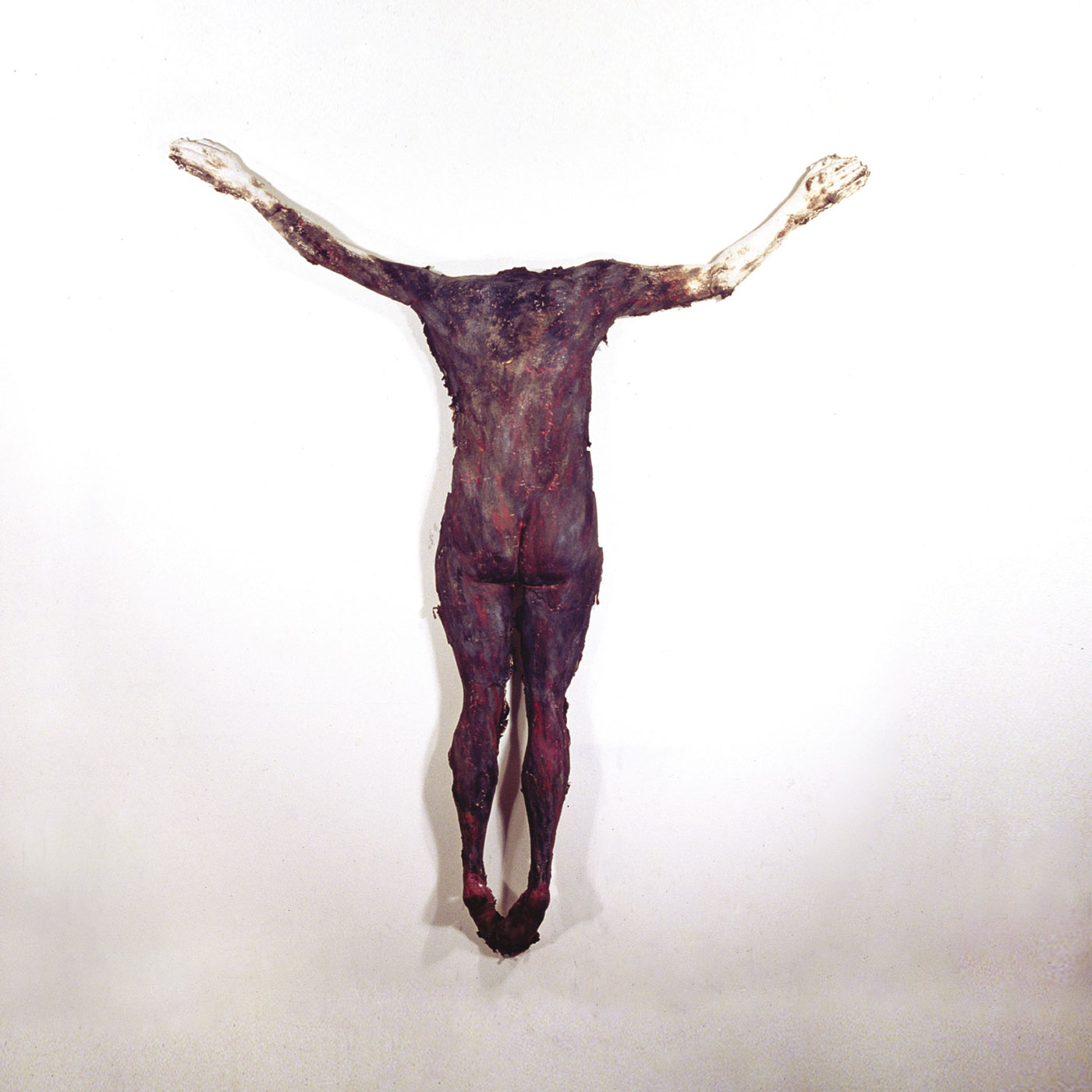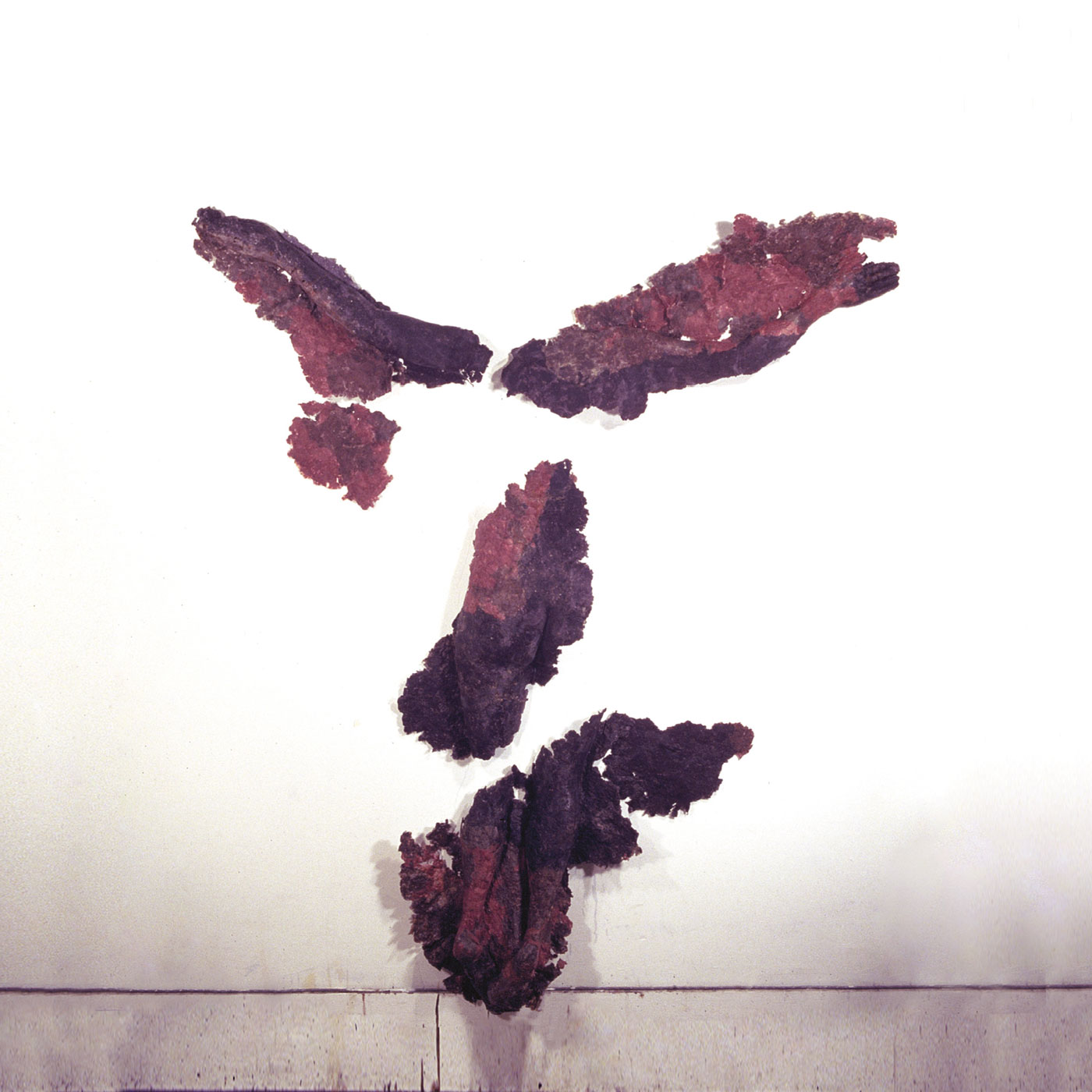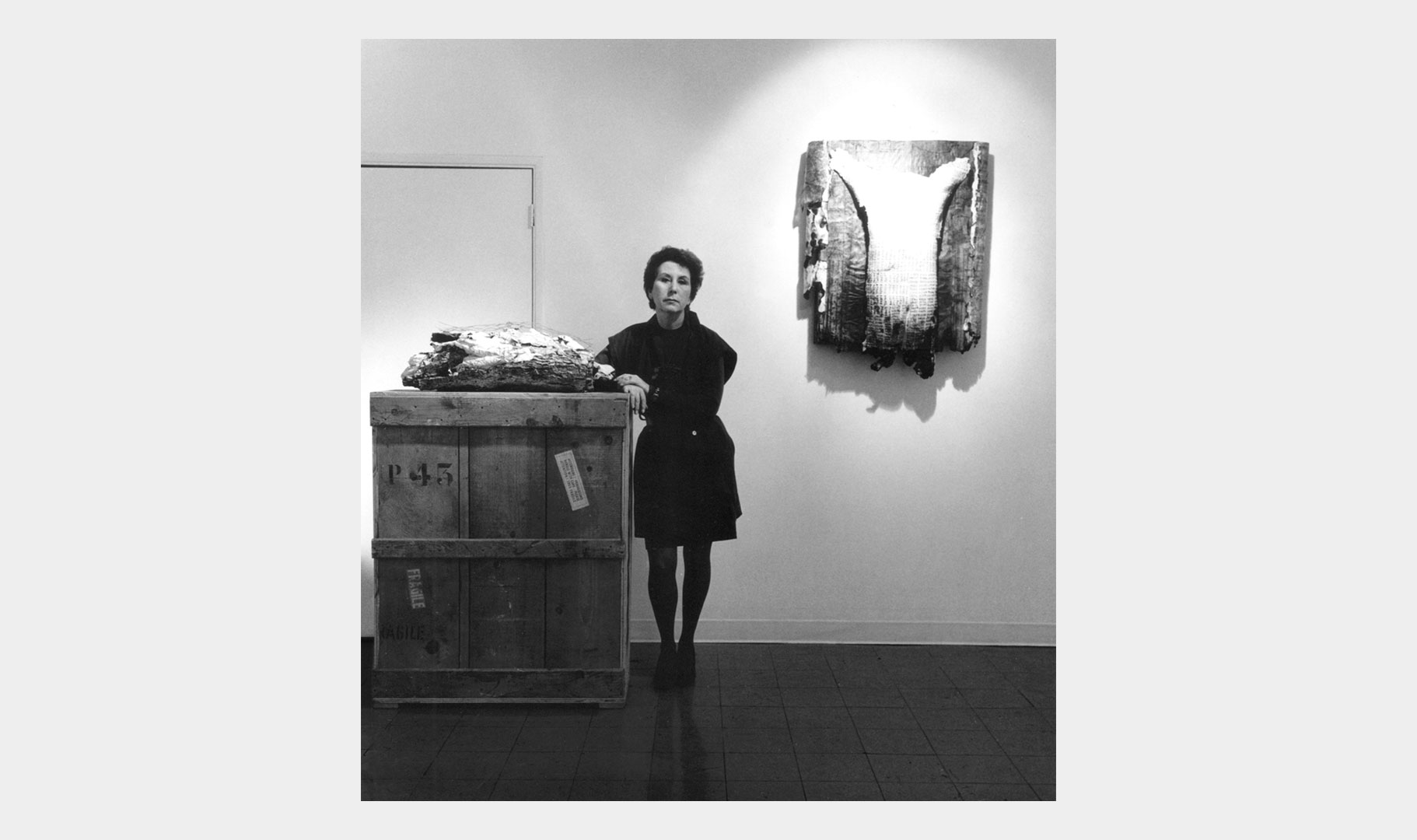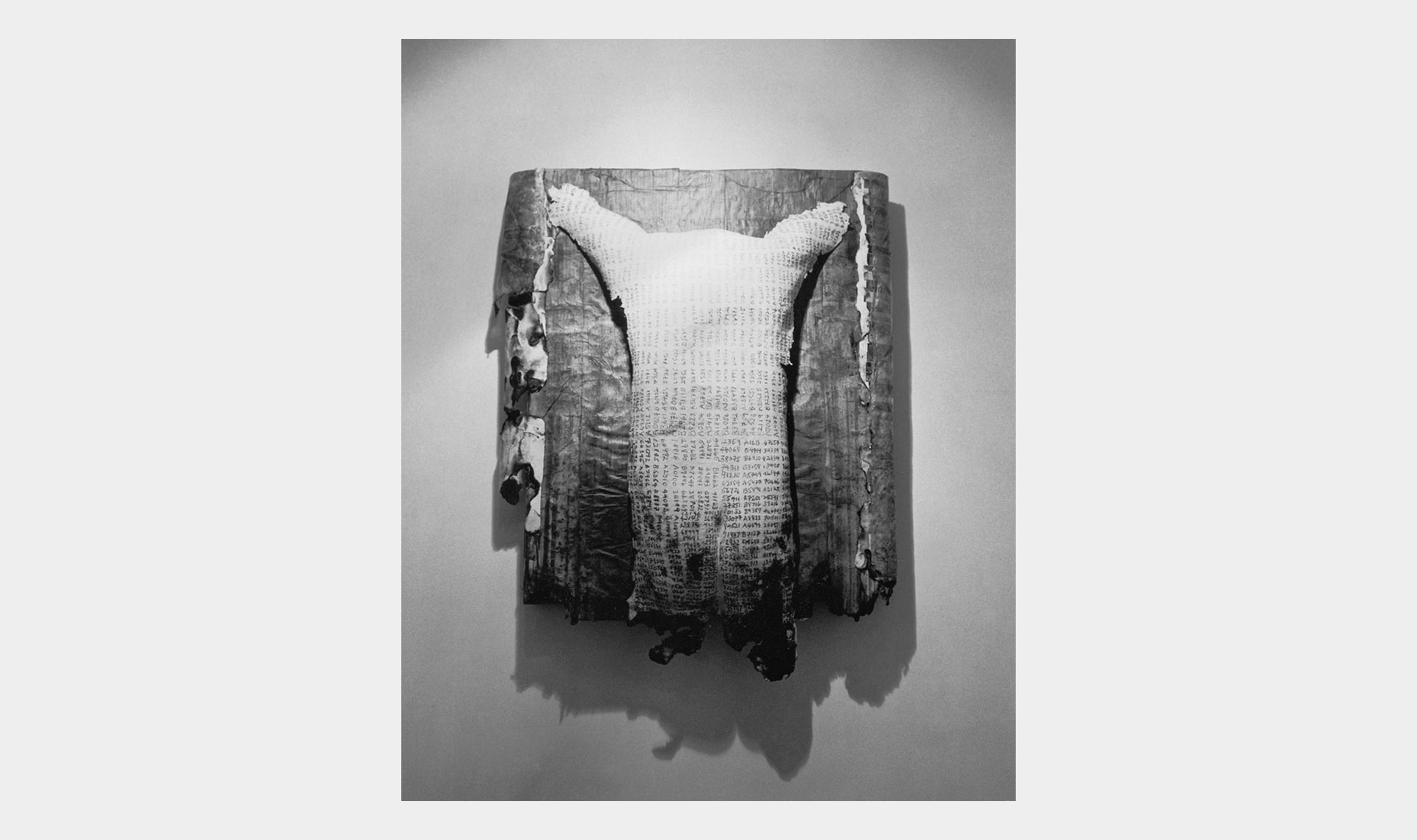SOCIAL PRACTICE
The Covid Masks were created during the pandemic and in the middle of my PAPER +Leaves Series which paired actual dried leaves with papers (and sometimes plastic). The disposable masks received photo transfers of actual newspaper clippings of nurses, Covid victims, hospital equipment, etc. Leaves represented the life force that was in jeopardy. The masks are presented as a “wearable” to underscore how personal all of this is to us.
COVID MASKS
The Angels constitute an almost serial consideration of the splayed (and perhaps flayed) body, hung as if crucified and bringing to mind the Crucifixion altarpieces of the early and high Renaissance. [continued]
ANGELS
ANGEL I: BOUND
1988, 13″ x 18″ x 25″
The particular injury depicted in this piece is that of being tied up and restrained in one’s life.
Process Information: Pulped Kozo, a very strong Japanese fiber, was given to me to experiment with and I formed it in the mold which had strips of raffia laid against the back portion. The raffia became imbedded in the pulp, enabling me to wrap it around the piece when I removed and folded it into the fetal position. It is displayed on a black lacquer pedestal covered with a Plexiglas box.
ANGEL II: BURNED
1988, 70″ x 62″ x 10″
I have long used burning in my nature subjects and the urban walls-themed pieces, but it is a very familiar form of human torture (e.g. Joan of Arc) and needs no interpretation. While most of the body is treated to resemble burned flesh, the hands and part of the arms are left as raw paper to juxtapose paper and flesh and imply that we are as fragile and combustible as paper.
Process: Abaca pulp painted with acrylic and heavily burned with a propane torch.
ANGEL III: FLAYED
1988, 68″ x 54″ x 10″
I have used many different papers to express qualities of human skin. With the painting of the inside of the piece so realistically to depict flayed skin, this is, by far, the most literal and evocative that I’ve produced.
Process: The same pre-beaten Japanese Kozo fiber used in Angel I: Bound. The paper shrank when dried as before, which is appropriate for this piece as it recalls rawhide or other flesh that has been peeled off and dried. Painted with acrylic. Ideally, the same red acrylic should be dripped onto the wall under the hands when installed.
ANGEL IV: FRAGMENTED
1988, 70″ x 62″ x 10″
This piece represents decay (as having been buried in the earth) as well as fragmentation. It expresses the emotional disconnectedness of people in distress.
Process: Cotton linters dyed with textile dyes, imbedded with vermiculite and coated with encaustic. A pattern is provided to install this piece correctly so that the forms of the body are consistent across the empty space.
ANGEL V: HARDENED
1988, 70″ x 62″ x 10″
We believe we can toughen ourselves against adversity, but there are always signs of cracking under pressure.
Process: Abaca pulp over-sprayed with faux granite and acrylic to simulate stone. The paper is cracked at two points.
ANGEL VI: CORRODED
1988, 79″ x 68″ x 10″
While we think we can protect ourselves, our personal armor (defenses) is badly corroded. Although the ascendant pose is the same as the other “Angels”, this one seems to be the most transcendent, perhaps, because the extensions from the body suggest wings.
Process: Abaca pulp painted in oils to give more of a sense of skin to the depiction of metal.
ANGEL VII: RENT
1988, 74″ x 62″ x 10″
The Holocaust represents the ultimate form of suffering at the hands of others and this tragedy is recalled in this “Angel.”
Process: The body of this figure is formed out of overlapping individual photocopies of my backside on Japanese Hosho paper. The Xerox prints were over-painted in gesso and inscribed using pen and ink. I replicated numbers and letters in the pattern of the tattooed numbers allocated to arrivals at the concentration camps. Japanese tissue was shredded to create a tattered shroud.
ANGEL VIII: STRIPPED
1988, 70″ x 62″ x 10″
There are three skin tones replicated – my freckled skin, African-American coloration, and a medium brown for Asian/Hispanic. The idea is that suffering is universal and that when one suffers, we all suffer.
Process: Spanish flax pulp tinted with Aardvark dyes.
ANGEL IX: TRAMMELLED
1988, 74″ x 62″ x 10″
Expresses the perception of being overrun by our technology and our highly mobile and frenetic lifestyle.
Process: Cast using cotton linters as the pulp. My car’s tires were painted with dye before running over the piece.
Their [the Angels] preoccupation with the pathetic fragility of the human body manifests in a yet more brittle way in the Personae, which present themselves as bodies disappearing into or emerging from masses of paper. This is especially true of the “Paper Becoming Me” sub-series from the mid-1980s and the subsequent “Circus Costumes” works, cast off the bodies of dancers posing in mid-movement. The dynamic of these works builds on the minimal and monumental “Life Casts” and the intimate “Chest” and “Hip” works. In contrast to the victimized passivity of the Angels, the figural presences in these subsequent pieces are active, even brave-seeming, plunging into or emerging from their paper shrouds with a vigor that at once asserts their vitality and exposes them to destructive forces – forces which Bleifer’s compositions imply are a constant factor in the human condition.
PETER FRANK
Art Critic, Curator, Poet
PAPER: PERSONA
HIROSHIMA/NAGASAKI MEMORIAL PROJECT
In the face of severe personal and ongoing family crises, Bleifer turned to her art as a means of working through grief, rage, fear and awareness of her own mortality. Bleifer then began making molded papers from casts of her own face, arms, breast and shoulder, legs, and finally casts of her whole body. From this came the series of disembodied limbs entitled “Hiroshima” and also the series “Paper Becoming Crucifixion.”
ISABEL ANDERSON
Paper Etiquette-Sandra Bleifer in Los Angeles, Visions Art Quarterly, Summer 1992
The Hiroshima/Nagasaki Memorial Series is comprised of 35 paper sculptures referencing the physical devastation of the bombings. It traveled to Hiroshima, Nagasaki, and Osaka in Japan and to Berkeley, Los Angeles, and Honolulu in the U.S. throughout 1994-5 accompanied by educational and community programs and artistic productions.

Hiroshima/Nagasaki Memorial Exhibition
Project Report, 1995
Archival catalog of a traveling exhibition of paper sculptures as an artistic response to the atomic bombing of Hiroshima and Nagasaki in 1945 produced by artist, Sandy Bleifer. The exhibition along with community, artistic and educational programs traveled to 3 cities in the U.S. and to Hiroshima, Nagasaki and Osaka in 1995, the 50th anniversary of the bombings.
Available for purchase on Blurb.com – a free e-book version is available also
CIRCUS COSTUMES
Costume design for a performance by the Santa Monica College Dance Program
May 1989
The idea behind the performance was to show the psycho-social interactions of the performers in the circus as parallel to life situations (e.g. the ringmaster where one man controls a group of competitive felines). Toward the end of the performance, the dancers take off their costumes (i.e. relinquish their role in the dynamics and revert back to who they are, basically, as individuals).
HOLOCAUST SERIES
Installation photographs by Keith Drosin of the Holocaust Series at LA Artcore Brewery Annex, Los Angeles, CA, 1996
The Holocaust Series catalog is available for purchase on Blurb.com – a free ebook version is available also.

The Holocaust Series Catalog
1994
A body of three dimensional figurative paper sculptures combined with wood and construction materials representing the interment of people in the concentration camps during the Holocaust. Strips of mold-infected papers symbolize the striped uniforms that were worn. The works remind us that these were once vibrant healthy people who were brutalized and killed in the concentration camps.



























